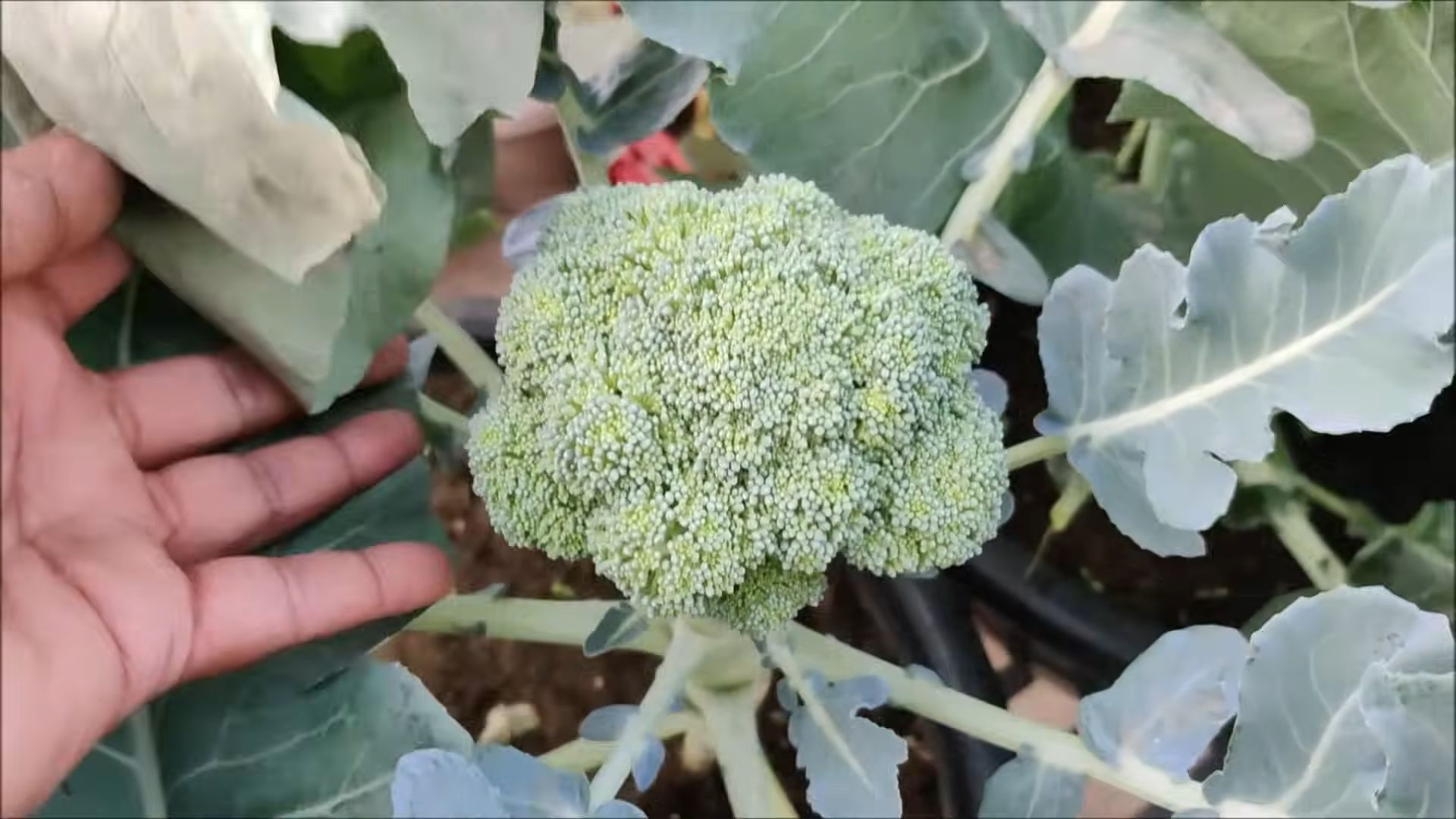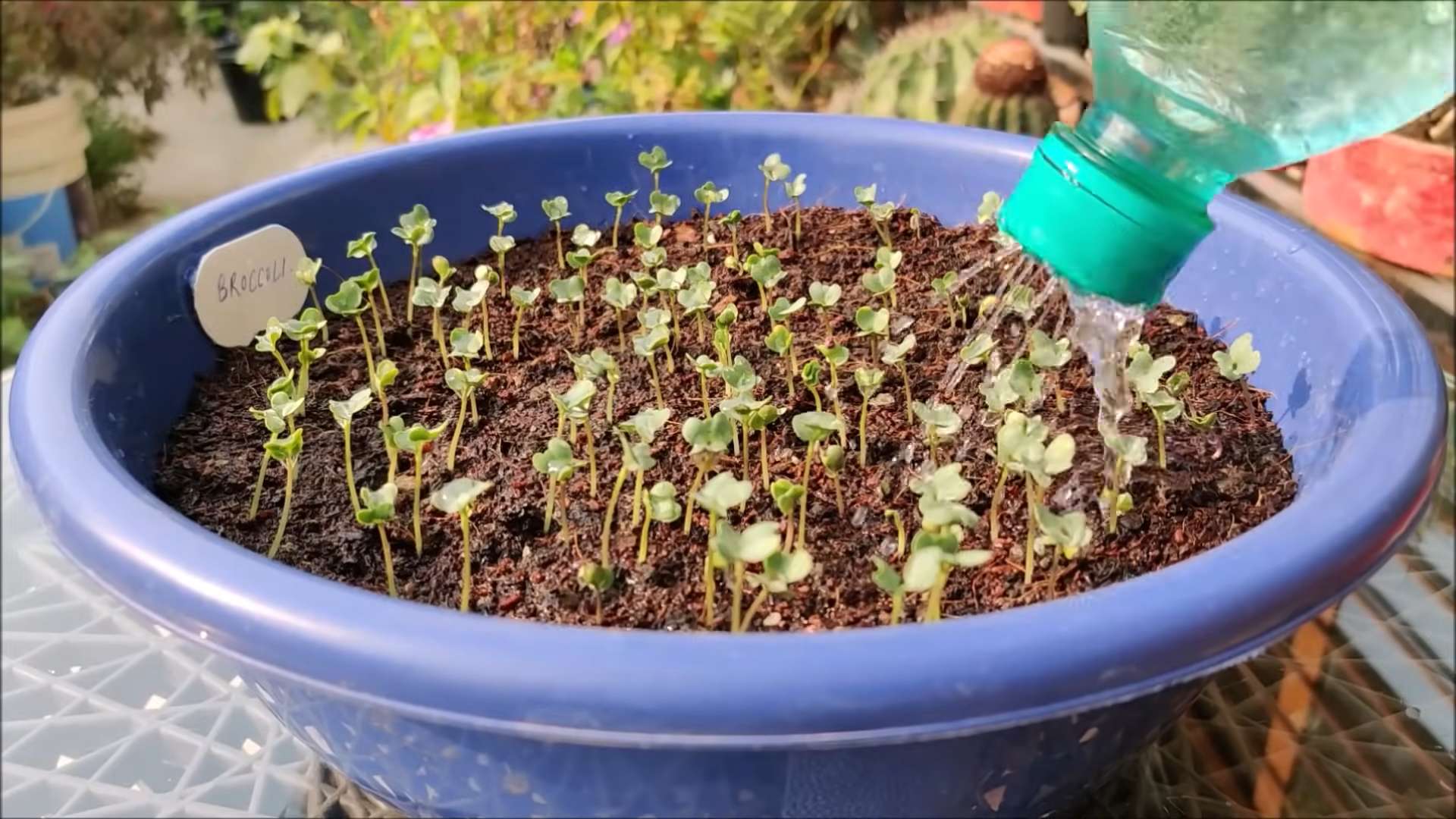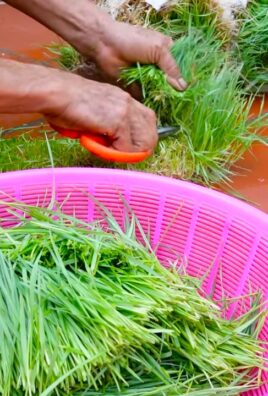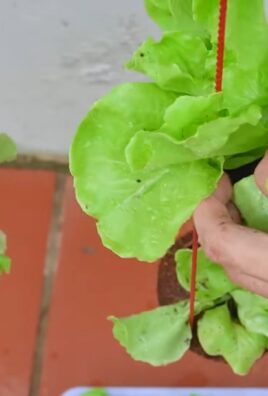Growing Broccoli at Home can seem daunting, but trust me, it’s more achievable (and rewarding!) than you might think. Have you ever imagined strolling into your backyard, snipping off a perfectly formed head of broccoli, and knowing exactly where it came from and what went into it? That’s the magic of home gardening!
Broccoli, a member of the brassica family, has a rich history, tracing back to ancient Roman times. It was considered a prized vegetable, carefully cultivated for its nutritional benefits and unique flavor. Today, its popularity continues to grow, and for good reason. But let’s face it, supermarket broccoli can sometimes be a letdown – bland, expensive, and lacking that fresh-from-the-garden vibrancy.
That’s where this DIY guide comes in! I’m going to share simple, effective tricks and hacks that will empower you to successfully growing broccoli at home, even if you’re a complete beginner. We’ll cover everything from seed starting to pest control, ensuring you harvest a bountiful crop of delicious, healthy broccoli. Why settle for store-bought when you can enjoy the satisfaction of growing your own? Let’s get our hands dirty and unlock the secrets to a thriving broccoli patch!

Growing Broccoli at Home: A Beginner’s Guide
Okay, so you want to grow your own broccoli? Awesome! It’s totally doable, even if you don’t have a huge garden. I’ve grown broccoli in everything from raised beds to large containers, and let me tell you, there’s nothing quite like the taste of fresh, homegrown broccoli. This guide will walk you through everything you need to know, from choosing the right variety to harvesting your delicious crop.
Choosing Your Broccoli Variety
First things first, let’s talk broccoli varieties. There are tons of options out there, and the best one for you will depend on your climate and how much space you have. Here are a few popular choices:
* ‘Waltham 29’: This is a classic, reliable variety that produces large, dark green heads. It’s a great all-around choice and does well in cooler climates.
* ‘Calabrese’: Another popular option, ‘Calabrese’ is known for its large central head and the smaller side shoots it produces after the main head is harvested. This means you get a longer harvest period!
* ‘DiCicco’: If you’re looking for a fast-growing variety, ‘DiCicco’ is a good bet. It produces smaller heads, but they mature quickly, usually in about 45-50 days.
* ‘Purple Sprouting’: For something a little different, try ‘Purple Sprouting’ broccoli. It produces lots of small, purple florets that are delicious and visually appealing. It’s also very cold-hardy.
* ‘Romanesco’: This one’s a showstopper! ‘Romanesco’ broccoli has a unique, fractal-like head that’s both beautiful and tasty. It’s a bit more challenging to grow than some other varieties, but the results are worth it.
Consider your local climate and growing season when making your choice. Check with your local nursery or garden center for recommendations on varieties that thrive in your area.
Starting Your Broccoli Seeds
You can either start your broccoli seeds indoors or sow them directly in your garden. I usually prefer to start them indoors, especially if I want an early start to the season.
* Starting Indoors:
* When to Start: About 6-8 weeks before the last expected frost in your area.
* What You’ll Need: Seed starting trays or small pots, seed starting mix, broccoli seeds, a spray bottle, and a grow light (optional, but recommended).
* Why Start Indoors?: Starting indoors gives your broccoli plants a head start, allowing them to mature earlier and produce a larger harvest. It also protects them from pests and diseases when they’re young and vulnerable.
* Direct Sowing:
* When to Sow: 2-3 weeks before the last expected frost, or in late summer for a fall harvest.
* What You’ll Need: Well-prepared garden soil, broccoli seeds, and a watering can.
* Why Direct Sow?: Direct sowing is simpler and eliminates the need for transplanting. However, it can be riskier, as the seedlings are more susceptible to pests, diseases, and harsh weather.
Step-by-Step Instructions: Starting Broccoli Seeds Indoors
Here’s how I start my broccoli seeds indoors:
1. Prepare Your Seed Starting Trays: Fill your seed starting trays or small pots with seed starting mix. Gently press down on the mix to remove any air pockets.
2. Sow the Seeds: Make a small indentation (about 1/4 inch deep) in the center of each cell or pot. Place 2-3 broccoli seeds in each indentation.
3. Cover the Seeds: Gently cover the seeds with seed starting mix.
4. Water the Seeds: Use a spray bottle to lightly mist the soil. You want to keep the soil moist but not soggy.
5. Provide Light: Place the trays or pots under a grow light or in a sunny window. If using a grow light, keep it a few inches above the soil surface.
6. Maintain Moisture: Check the soil daily and mist with water as needed to keep it moist.
7. Thin the Seedlings: Once the seedlings have emerged and have a few true leaves (the leaves that look like miniature broccoli leaves), thin them to one plant per cell or pot. Choose the strongest, healthiest-looking seedling and snip off the others at the soil line.
8. Harden Off the Seedlings: About a week before you plan to transplant the seedlings into your garden, you’ll need to “harden them off.” This means gradually exposing them to outdoor conditions to help them adjust. Start by placing them outside in a sheltered spot for a few hours each day, gradually increasing the amount of time they spend outdoors.
Step-by-Step Instructions: Direct Sowing Broccoli Seeds
If you’re opting for direct sowing, here’s what to do:
1. Prepare the Soil: Choose a sunny spot in your garden with well-drained soil. Amend the soil with compost or other organic matter to improve its fertility and drainage.
2. Sow the Seeds: Sow the seeds about 1/2 inch deep and 1-2 inches apart in rows.
3. Water the Seeds: Gently water the soil after sowing.
4. Thin the Seedlings: Once the seedlings have emerged and have a few true leaves, thin them to the desired spacing (see below).
Transplanting Your Broccoli Seedlings
Once your seedlings are about 4-6 inches tall and have been hardened off, it’s time to transplant them into your garden.
1. Prepare the Planting Site: Choose a sunny spot in your garden with well-drained soil. Broccoli needs at least 6 hours of sunlight per day.
2. Amend the Soil: Amend the soil with compost or other organic matter to improve its fertility and drainage. Broccoli is a heavy feeder, so it needs nutrient-rich soil.
3. Space the Plants: Space the plants about 18-24 inches apart in rows that are 24-36 inches apart. This will give them enough room to grow and mature.
4. Dig the Holes: Dig holes that are slightly larger than the root balls of the seedlings.
5. Transplant the Seedlings: Gently remove the seedlings from their trays or pots and place them in the holes. Make sure the top of the root ball is level with the surrounding soil.
6. Fill the Holes: Fill the holes with soil and gently firm it around the base of the plants.
7. Water the Plants: Water the plants thoroughly after transplanting.
Caring for Your Broccoli Plants
Once your broccoli plants are in the ground, there are a few things you’ll need to do to keep them healthy and productive.
* Watering: Broccoli needs consistent moisture, especially during hot, dry weather. Water deeply whenever the top inch of soil feels dry.
* Fertilizing: Broccoli is a heavy feeder, so it needs regular fertilization. Apply a balanced fertilizer every 2-3 weeks, following the instructions on the package. You can also side-dress with compost or other organic matter.
* Weeding: Keep the area around your broccoli plants free of weeds. Weeds compete with the broccoli for water and nutrients.
* Pest Control: Broccoli is susceptible to a few common pests, including cabbage worms, aphids, and flea beetles. Check your plants regularly for signs of infestation and take action as needed.
* Cabbage Worms: These green caterpillars can quickly devour broccoli leaves. Handpick them off the plants or use a biological insecticide like Bacillus thuringiensis (Bt).
* Aphids: These tiny insects suck the sap from broccoli leaves, causing them to curl and yellow. Spray the plants with a strong stream of water or use insecticidal soap.
* Flea Beetles: These small, jumping beetles can create tiny holes in broccoli leaves. Cover the plants with row covers to prevent them from reaching the plants.
* Disease Control: Broccoli can also be affected by a few common diseases, including black rot and clubroot.
* Black Rot: This bacterial disease causes yellow, V-shaped lesions on broccoli leaves. Plant disease-resistant varieties and avoid overhead watering.
* Clubroot: This fungal disease causes swollen, distorted roots. Rotate your crops and amend the soil with lime to raise the pH.
Harvesting Your Broccoli
The moment you’ve been waiting for! Knowing when to harvest is key to getting the best flavor and texture.
* When to Harvest: Harvest your broccoli when the central head is firm and the florets are tightly closed. If the florets start to open and turn yellow, it’s time to harvest immediately.
* How to Harvest: Use a sharp knife to cut the central head from the plant, leaving a few inches

Conclusion
So, there you have it! Growing broccoli at home, while it might seem daunting at first, is an incredibly rewarding experience. It’s not just about saving money (though that’s a definite perk!), it’s about connecting with your food, understanding the process from seed to table, and enjoying the unparalleled flavor of freshly harvested, homegrown broccoli.
Why is this DIY trick a must-try? Because store-bought broccoli simply can’t compare. The flavor is often muted, and you have no control over the growing conditions or the pesticides used. When you grow your own, you know exactly what you’re getting: healthy, delicious, and vibrant broccoli packed with nutrients. Plus, the satisfaction of nurturing a plant from a tiny seed to a bountiful harvest is truly unmatched.
But the benefits extend beyond just taste and health. Growing your own broccoli is also a fantastic way to reduce your carbon footprint. Think about all the transportation and packaging involved in getting broccoli from a farm to your local grocery store. By growing your own, you’re eliminating those unnecessary steps and contributing to a more sustainable lifestyle.
Variations and Suggestions:
Don’t be afraid to experiment! There are many different varieties of broccoli to choose from, each with its own unique flavor and characteristics. Try growing ‘Waltham 29’ for a classic, reliable choice, or ‘Romanesco’ for its stunning geometric florets and nutty flavor. You can even try growing sprouting broccoli, which produces smaller, more tender florets over a longer period.
Consider companion planting to maximize your garden’s potential. Broccoli thrives alongside herbs like rosemary and thyme, which can help deter pests. Marigolds are also a great addition to your broccoli patch, as they attract beneficial insects that prey on aphids and other common broccoli pests.
If you’re short on space, don’t worry! Broccoli can be successfully grown in containers. Just make sure to choose a large enough pot (at least 12 inches in diameter) and use a high-quality potting mix. Container-grown broccoli will likely need more frequent watering and fertilizing than broccoli grown in the ground.
And remember, growing broccoli is a learning process. Don’t be discouraged if you encounter challenges along the way. Every mistake is an opportunity to learn and improve your gardening skills.
We wholeheartedly encourage you to give this DIY trick a try. Start small, be patient, and enjoy the journey. We’re confident that you’ll be amazed by the results. Imagine serving a delicious broccoli dish made entirely from ingredients you grew yourself. It’s a truly rewarding experience.
So, grab some seeds, prepare your soil, and get ready to embark on your broccoli-growing adventure! And most importantly, don’t forget to share your experiences with us! We’d love to hear about your successes, your challenges, and any tips or tricks you’ve learned along the way. Share your photos and stories on social media using #HomegrownBroccoli or leave a comment below. Let’s build a community of broccoli-loving gardeners! Growing your own broccoli is easier than you think, and the rewards are well worth the effort. Happy gardening!
Frequently Asked Questions (FAQ)
Q: What is the best time of year to plant broccoli?
A: The best time to plant broccoli depends on your climate. Broccoli is a cool-season crop, so it thrives in temperatures between 60°F and 70°F. In most regions, you can plant broccoli in early spring for a summer harvest or in late summer for a fall harvest. If you live in a warmer climate, you may be able to grow broccoli throughout the winter. Check your local frost dates to determine the best planting time for your area. Generally, you want to start seeds indoors 6-8 weeks before the last expected frost in spring, or direct sow seeds 8-10 weeks before the first expected frost in fall.
Q: How much sunlight does broccoli need?
A: Broccoli needs at least 6 hours of direct sunlight per day to thrive. Choose a sunny location in your garden where your broccoli plants will receive ample sunlight. If you’re growing broccoli in containers, make sure to place them in a sunny spot. If you live in a particularly hot climate, some afternoon shade can be beneficial to prevent the plants from bolting (going to seed prematurely).
Q: What kind of soil is best for growing broccoli?
A: Broccoli prefers well-drained, fertile soil that is rich in organic matter. Amend your soil with compost or well-rotted manure before planting to improve its fertility and drainage. Broccoli also prefers a slightly acidic to neutral soil pH, between 6.0 and 7.0. You can test your soil pH with a soil testing kit and amend it accordingly.
Q: How often should I water my broccoli plants?
A: Broccoli plants need consistent moisture to thrive. Water your broccoli plants deeply whenever the top inch of soil feels dry to the touch. Avoid overwatering, as this can lead to root rot. Mulching around your broccoli plants can help retain moisture in the soil and suppress weeds. During hot, dry weather, you may need to water your broccoli plants more frequently.
Q: What are some common pests and diseases that affect broccoli?
A: Broccoli is susceptible to a variety of pests and diseases, including aphids, cabbage worms, flea beetles, clubroot, and downy mildew. Regularly inspect your broccoli plants for signs of pests or diseases. You can control aphids with insecticidal soap or neem oil. Cabbage worms can be handpicked or controlled with Bacillus thuringiensis (Bt). Flea beetles can be controlled with row covers or diatomaceous earth. Clubroot can be prevented by practicing crop rotation and maintaining a soil pH above 7.0. Downy mildew can be prevented by providing good air circulation and avoiding overhead watering.
Q: How do I know when my broccoli is ready to harvest?
A: Broccoli is ready to harvest when the flower buds are tight and compact, and the head is firm. The size of the head will vary depending on the variety, but generally, you should harvest the head when it reaches about 6-8 inches in diameter. Use a sharp knife to cut the head from the plant, leaving a few inches of stem attached. After harvesting the main head, your broccoli plant may produce smaller side shoots, which can also be harvested.
Q: Can I grow broccoli indoors?
A: While it’s possible to start broccoli seeds indoors, it’s generally not recommended to grow broccoli entirely indoors. Broccoli needs a lot of sunlight and space to thrive, which can be difficult to provide indoors. However, you can start your broccoli seeds indoors 6-8 weeks before the last expected frost and then transplant them outdoors once the weather warms up.
Q: How do I store harvested broccoli?
A: To store harvested broccoli, wrap it loosely in a damp paper towel and place it in a plastic bag in the refrigerator. Broccoli can be stored in the refrigerator for up to a week. You can also freeze broccoli for longer storage. To freeze broccoli, blanch it in boiling water for 3-5 minutes, then plunge it into ice water to stop the cooking process. Drain the broccoli and spread it out on a baking sheet to freeze. Once frozen, transfer the broccoli to a freezer bag or container.
Q: What are some ways to use homegrown broccoli?
A: The possibilities are endless! You can steam, roast, stir-fry, or grill your homegrown broccoli. It’s delicious in salads, soups, and casseroles. You can also use it to make broccoli cheese soup, broccoli slaw, or broccoli fritters. Don’t forget to use the stems too! They can be peeled and chopped and added to stir-fries or soups. Homegrown broccoli is a versatile and nutritious ingredient that can be enjoyed in countless ways.




Leave a Comment